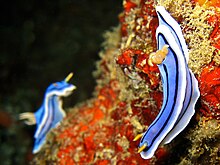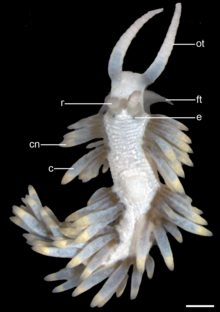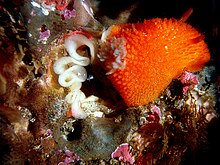Nudibranch
| Nudibranch | |
|---|---|

| |
| Berghia coerulescens | |

| |
| A pair of Chromodoris lochi from Puerto Galera, the Philippines. | |
| Scientific classification | |
| Kingdom: | |
| Phylum: | |
| Class: | |
| (unranked): | |
| Clades | |
|
See text for superfamilies | |
A nudibranch (Template:Pron-en)[1] is a member of what is now a taxonomic clade, and what was previously a suborder, of soft-bodied, marine gastropod mollusks which shed their shell after their larval stage.[2] They are noted for their often extraordinary colors and striking forms. The clade Nudibranchia is the largest clade within the heterobranchs, with more than 3,000 described species.
The word "nudibranch" comes from the Latin nudus, naked, and the Greek brankhia, gills.
Nudibranchs are often casually called "sea slug", but many sea slugs belong to several taxonomic groups which are not related to nudibranchs. A number of these other sea slugs (such as the colorful Aglajidae) are often confused with nudibranchs.
Distribution
Nudibranchs occur in seas worldwide.
Habitat
Nudibranchs live at virtually all depths of salt water, but reach their greatest size and variation in warm, shallow waters.

ot = oral tentacles,
ft = foot tentacles,
e = eye,
r = rhinophores,
c = cerata. This species has cnidosacs at the cerata tips.


Description
The body forms of nudibranchs vary enormously, but because they are opisthobranchs, unlike most other gastropods they are bilaterally symmetrical because they have undergone secondary detorsion. Some species have venomous appendages on their sides. These are used to deter predators. Many also have a simple gut and a mouth with a radula.
They lack a mantle cavity.

Their eyes are simple and able to discern little more than light and dark.[3] The eyes are set into the body, are about a quarter of a millimeter in diameter, and consist of a lens and five photoreceptors.[4]
They vary in adult size from 20 to 600 millimetres (0.79 to 23.62 in).
The adult form is without a shell or operculum (a bony or horny plate covering the opening of the shell, when the body is withdrawn).
The name nudibranch is appropriate, since the dorids (infraclass Anthobranchia) breathe through a "naked gill shaped" like branchial plumes of bushy extremities on their back, near their tail rather than using gills.[5] By contrast, on the back of the aeolids in the clade Cladobranchia there are brightly colored sets of protruding organs called cerata.
Nudibranchs have cephalic (head) tentacles, which are sensitive to touch, taste, and smell. Club-shaped rhinophores detect odors.
Life habits
Reproduction



Nudibranchs are hermaphroditic, and thus have a set of reproductive organs for both sexes, but they can rarely fertilize themselves.
Nudibranchs typically deposit their eggs within a gelatinous spiral.[6]
Feeding
Most nudibranchs are carnivorous. Some feed on sponges, others on hydroids,(e.g. Cuthona )[7] others on bryozoans (phanerobranchs such as Tambja, Limacia, Plocamopherus and Triopha)[8], and some eat other sea slugs or their eggs (e.g. Favorinus)[9] or, on some occasions, are cannibals and prey on members of their own species. Other groups feed on tunicates (e.g. Tambja, Nembrotha, Polycera, Thecacera)[10], other nudibranchs (Roboastra, which are descended from tunicate-feeding species)[10], barnacles (e.g. Onchidoris)[11], and anemones (e.g. the Aeolidiidae and other Cladobranchia)[8].

The surface dwelling nudibranch, Glaucus atlanticus is a specialist predator of siphonophores, such as the Portuguese Man O' War. This predatory mollusk sucks air into its stomach to keep it afloat and using its muscular foot it clings to the surface film. If it finds a small victim Glaucus simply envelops it with its capacious mouth, but if the prey is a larger siphonophore the mollusk nibbles off its fishing tentacles, the ones carrying the most potent nematocysts. Like some others of its kind Glaucus does not digest the nematocysts; instead, it uses them to defend itself by passing them from its gut to the surface of its skin.[12]
For a comprehensive list of nudibranch feeding preferences, see the electronic supplement from [13]
Defense mechanisms
This group includes some of the most colorful creatures on earth. In the course of evolution, sea slugs have lost their shell because they have developed other defense mechanisms. Some species evolved an external anatomy with textures and colors that mimicked surrounding plants to avoid predators (see camouflage). Other nudibranchs, as seen especially well on chromodorids, have an intensely bright and contrasting color pattern that makes them especially conspicuous in their surroundings. This is believed to be an example of aposematic coloration; the shocking coloration warns potential predators that the slugs are distasteful or poisonous. Evolutionarily, aposematic coloring does not make sense: a bright, conspicuous novel color form would likely be prone to attack before having the chance to reproduce. One explanation for this apparent paradox is the idea of dietary conservatism in predators. This behavior, which involves avoidance of novel food sources, has been shown in many species of predatory birds, with some examples so strong that birds will starve before eating an unfamiliar prey.[14]
Nudibranchs that feed on hydroids can store the hydroids' nematocysts (stinging cells) in the dorsal body wall, the cerata.[15] These stolen nematocysts, called kleptocnidae, wander through the alimentary tract without harming the nudibranch. Once further into the organ, the cells are brought to specific placements on the creature's hind body via intestinal protuberances. Nudibranches can protect themselves from the hydroids and their nematocysts. It is not yet clear how, but special cells with large vacuoles probably play an important role. They can also take in plants' chloroplasts (plant cell organelles used for photosynthesis) and use them to make food for themselves.
Nudibranchs use a variety of chemical defenses to aid in protection, but it is not necessary for the strategy to be lethal in order to be effective: some successful toxins induce bradycardia or hypotension in a predator, allowing the nudibranch to escape consumption while its attacker is incapacitated.[16] Some sponge-eating nudibranchs concentrate the toxins from their prey sponge in their bodies, rendering themselves toxic to predators.[17] The evidence that suggests the toxins used by dorid nudibranchs do in fact come from dietary sponges lies in the similarities between the primary and secondary metabolites of prey and nudibranchs, respectively. Furthermore, nudibranchs contain a mixture of sponge chemicals when they are in the presence of multiple food sources as well as change defense chemicals with a concurrent change in diet.[18] This, however, is not the only way for nudibranchs to develop chemical defenses. Certain species are able to produce their own chemicals de novo without dietary influence. Evidence for the different methods of chemical production comes with the characteristic uniformity of chemical composition across drastically different environments and geographic locations found throughout de novo production species compared to the wide variety of dietary and environmentally dependent chemical composition in sequestering species.[19]
Another method of protection is the release of an acid from the skin.[20] Once the specimen is physically irritated or touched by another creature, it will release the mucus automatically.
Taxonomy
The taxonomy of the Nudibranchia is still under investigation. Many taxonomists in the past treated the Nudibranchia as an order, based on the authoritative work of Johannes Thiele (1931), who built on the concepts of Henri Milne-Edwards (1848).
- Infraorder Anthobranchia Férussac, 1819 (dorids)
- Superfamily Doridoidea Rafinesque, 1815
- Superfamily Doridoxoidea Bergh, 1900
- Superfamily Onchidoridoidea Alder & Hancock, 1845
- Superfamily Polyceroidea Alder & Hancock, 1845
- Infraorder Cladobranchia Willan & Morton, 1984 (aeolids)
- Superfamily Aeolidioidea J. E. Gray, 1827
- Superfamily Arminoidea Rafinesque, 1814
- Superfamily Dendronotoidea Allman, 1845
- Superfamily Metarminoidea Odhner in Franc, 1968
Newer insights derived from morphological data and gene-sequence research, have confirmed these ideas. On the basis of investigation of 18S rDNA sequence data, there is strong evidence for support of the monophyly of the Nudibranchia and its two major groups, the Anthobranchia/Doridoidea and Cladobranchia.[21] A study published in May 2001, has again revised the taxonomy of the Nudibranchia.[22] They are thus divided into two major clades:
- Anthobranchia (= Bathydoridoidea + Doridoidea)
- Dexiarchia nom. nov. (= Doridoxoidea + Dendronotoidea + Aeolidoidea + “Arminoidea”).
The dorids (infraorder Anthobranchia) have the following characteristics: the branchial plume forms a cluster on the posterior part of the body, around the anus. Fringes on the mantle do not contain any intestines.
The aeolids (infraorder Cladobranchia) have the following characteristics: Instead of the branchial plume, they have cerata. They lack a mantle. Only species of the Cladobranchia are reported to house zooxanthellae.
According to the taxonomy by Bouchet & Rocroi (2005), currently the most up-to-date system of classifying the gastropods , the Nudibranchia are a subclade within the clade of the Nudipleura. The Nudibranchia are then divided into two clades :
- Clade Euctenidiacea (= Holohepatica)
- Clade Nudibranchia Dexiarchia (= Actenidiacea)



References
- ^ Longman Pronunciation Dictionary (2nd edition), ISBN 0582364671
- ^ Attention: This template ({{cite doi}}) is deprecated. To cite the publication identified by doi:10.1017/S0025315400006044 , please use {{cite journal}} (if it was published in a bona fide academic journal, otherwise {{cite report}} with
|doi=10.1017/S0025315400006044instead. - ^ http://ngm.nationalgeographic.com/2008/06/nudibranchs/holland-text/2
- ^ CHASE, RONALD (June 1, 1974). "The Electrophysiology of Photoreceptors in the Nudibranch Mollusc, Tritonia Diomedia". Journal of experimental biology. 60 (3): 707. PMID 4847278.
- ^ Dayrat, B. (2005). "Advantages of naming species under the PhyloCode: An example of how a new species of Discodorididae (Mollusca, Gastropoda, Euthyneura, Nudibranchia, Doridina) may be named" (PDF). Marine Biology Research. 1 (3): 216–232. doi:10.1080/17451000510019141. Retrieved 2009-06-14.
- ^ Klussmann-Kolb A (2001). "The Reproductive Systems of the Nudibranchia (Gastropoda, Opisthobranchia): Comparative Histology and Ultrastructure of the Nidamental Glands with Aspects of Functional Morphology". Zoologischer Anzeiger. 240 (2): 119–136. doi:10.1078/0044-5231-00011.
- ^ NC Folino (1997). "The role of prey mobility in the population ecology of the nudibranch Cuthona nana (Gastropoda: Opisthobranchia)" (PDF). American Malacological Bulletin.
- ^ a b Attention: This template ({{cite doi}}) is deprecated. To cite the publication identified by doi:10.1111/j.1096-3642.2008.00390.x, please use {{cite journal}} (if it was published in a bona fide academic journal, otherwise {{cite report}} with
|doi=10.1111/j.1096-3642.2008.00390.xinstead. - ^ Rudman, W.B., (1999 (March 19)). "Favorinus tsuruganus Baba & Abe, 1964. [In] Sea Slug Forum. Australian Museum".
{{cite web}}: Check date values in:|year=(help)CS1 maint: extra punctuation (link) CS1 maint: multiple names: authors list (link) - ^ a b Attention: This template ({{cite doi}}) is deprecated. To cite the publication identified by doi:10.1111/j.1095-8312.2004.00413.x, please use {{cite journal}} (if it was published in a bona fide academic journal, otherwise {{cite report}} with
|doi=10.1111/j.1095-8312.2004.00413.xinstead. - ^ Attention: This template ({{cite jstor}}) is deprecated. To cite the publication identified by jstor:1986 , please use {{cite journal}} with
|jstor=1986instead. - ^ Piper, Ross (2007), Extraordinary Animals: An Encyclopedia of Curious and Unusual Animals, Greenwood Press.
- ^ MCDONALD, G. R., & J. W. NYBAKKEN. 1997. A worldwide review of the food of nudibranch mollusks. I. Introduction and the suborder Arminacea. Veliger 40(2): 157-159.
MCDONALD, G. R., & J. W. NYBAKKEN. 1999. A worldwide review of the food of nudibranch mollusks. II. The suborder Dendronotacea. Veliger 42(1): 62-66.
{{cite journal}}: Cite journal requires|journal=(help); Missing or empty|title=(help); line feed character in|author=at position 164 (help)CS1 maint: multiple names: authors list (link) CS1 maint: numeric names: authors list (link) - ^ Marples, N. M., D. J. Kelly, and R. J. Thomas. 2005. Perspective: The evolution of warning coloration is not paradoxical. Evolution 59:933-940
- ^ Frick, K (2003). "Predator Suites and Flabellinid Nudibranch Nematocyst Complements in the Gulf of Maine". In: SF Norton (ed). Diving for Science...2003. Proceedings of the American Academy of Underwater Sciences (22nd Annual Scientific Diving Symposium). Retrieved 2008-07-03.
- ^ Fuhrman, F. A., G. J. Fuhrman, and K. Deriemer. 1979. Toxicity and pharmacology of extracts from dorid nudibranchs. Biological Bulletin 156:289-299
- ^ Gosliner, T.M. 1987. Nudibranchs of Southern Africa ISBN 0-930118-13-8
- ^ Faulkner, D. J., and M. T. Ghiselin. 1983. Chemical defense and evolutionary ecology of dorid nudibranchs and some other opisthobranch gastropods. Marine Ecology-Progress Series 13:295-301.
- ^ Barsby, T., R. G. Linington, and R. J. Andersen. 2002. De Novo terpenoid biosynthesis by the dendronotid nudibranch Melibe leonina. Chemoecology 12:199-202
- ^ Edmunds, M. 1968. Acid secretion in some species of Doridacea (Mollusca, Nudibranchia). Proceedings of the Malacological Society of London 38:121-133
- ^ Wägele H. & Willan R. C. (2000). "Phylogeny of the Nudibranchia". Zoological Journal of the Linnean Society. 1 (1): 83–181. doi:10.1111/j.1096-3642.2000.tb02196.x.
{{cite journal}}: Unknown parameter|month=ignored (help) - ^ Schrödl M., Wägele H. & Willan R. C. (2001). "Taxonomic Redescription of the Doridoxidae(Gastropoda: Opisthobranchia), an Enigmatic Family of Deep Water Nudibranchs, with Discussion of Basal Nudibranch Phylogeny". Zoologischer Anzeiger. 240 (1): 83–97. doi:10.1078/0044-5231-00008.
Further reading
- Gary R. McDonald. July 29, 2006. Nudibranch Systematic Index. Institute of Marine Sciences. Paper Nudibranch_Systematic_Index. - Note: This is a good resource for getting a species list in certain genera, but it is not good for ascertaining the taxonomy of a genera, because it does not use the taxonomy of the Gastropoda (Bouchet & Rocroi, 2005).
- Neville Coleman (2008). Nudibranchs Encyclopedia: Catalogue of Asia/Indo-Pacific Sea Slugs. Neville Coleman's Underwater Geographic. ISBN 0947325417
External links
- Images, information and identification of Nudibranchs
- Sea Slug Forum by William B. Rudman
- World of Water by Neville Coleman (Encyclopedia and photos)
- Nudibranchs in their natural environment, Scuba Diving - Narooma NSW
- Nudi Pixel: Online resource for nudibranchs and sea slugs identification using photographs
- Various nudibranch species from Indonesia, Philippines and Thailand
- Nudibranch gallery
- Bibliography and portal to opisthobranch, nudibranch & seaslug information
- Nudibranch photo gallery from Bali
- Scottish Nudibranchs: Online resource for identification of species found in Scottish waters
- Born to be Wild: Sea Slugs, 04/30/2008
- http://ngm.nationalgeographic.com/2008/06/nudibranchs/doubilet-photography?email=focus_20080523
- Sea slugs of Hawaii
- Marine Conservation Cambodia: A Photographic Database of Cambodian Nudibranch
- Slug City - Molluscs. Brain & Behavior, from the University of Illinois at Urbana-Champaign
iPhone App
- inudibranch.com This field guide will place right at your fingertips, anytime and anywhere, an outstanding selection of 700 species of Nudibranch found in the Central Indo-Pacific Region from Japan to Australia, a zone where marine fauna diversity is at its greatest.
No web connection required!
Videos
- The Lynx Nudibranch HD clip of Phidiana lynceus carefully consuming a hydroid, Myrionema amboinense.
- Slug City - Molluscs. Brain & Behavior, many videos of nudibranchs from the University of Illinois at Urbana-Champaign
